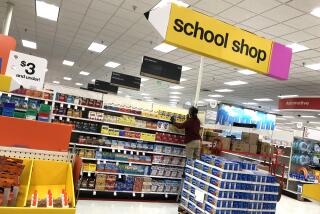Back-to-school sales expected to decline from last year
- Share via
A possible slowdown in back-to-school shopping could weaken the retail industry’s recent momentum, according to sales estimates from several retail groups.
As retailers roll out fresh back-to-school merchandise and tout early deals, a “shadow of insecurity” tied to the nation’s slow economic recovery still looms over many consumers and could hamper their spending, the National Retail Federation said.
The retail trade group said in a report Thursday that families with children in kindergarten through high school would spend an average of $603.63 on apparel, school supplies and electronics, down slightly from $606.40 during last year’s back-to-school season.
Many shoppers said they would purchase more store-brand or generic items, comparison shop online and look for sales to save money. More people will put their shopping off until late in the season: 31.2% of respondents said they would begin their shopping one or two weeks before school starts, up from 24.8% last year.
“Parents want their children to take a good look around at what they already have before deciding what to buy for back-to-school this year,” said Matthew Shay, president of the National Retail Federation.
At the college level, parents and students will spend an average of $808.71 on apparel, electronics, dorm furnishings and food items, down from $835.73 last year.
Combined kindergarten-through-college spending is expected to reach $68.8 billion, according to the retail federation. The three-month back-to-school season is typically the second-largest sales driver of the year (after the winter holidays).
Marshal Cohen, chief industry analyst at NPD Group, said consumers were “approaching this season in a more cautious frame of mind.” The market research firm’s own back-to-school study showed that more consumers planned to spend less this year.
Another retail group, the International Council of Shopping Centers, has taken a slightly more optimistic view, predicting this month that sales for the season would rise 3% year-over-year.
Still, that would be a modest gain and below the mid-single-digit sales growth the industry has seen for much of this year.
More to Read
Inside the business of entertainment
The Wide Shot brings you news, analysis and insights on everything from streaming wars to production — and what it all means for the future.
You may occasionally receive promotional content from the Los Angeles Times.










